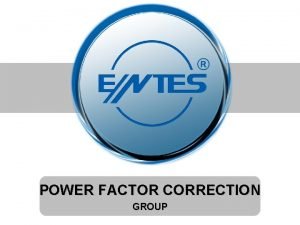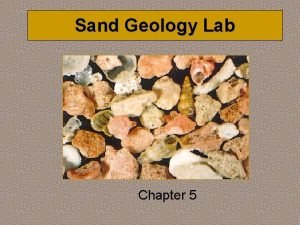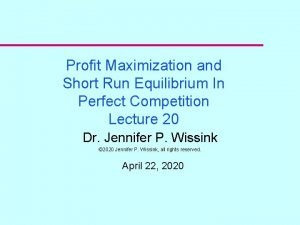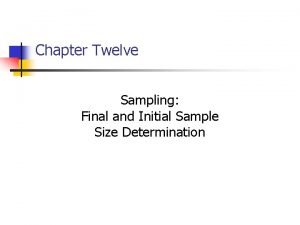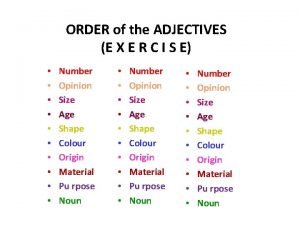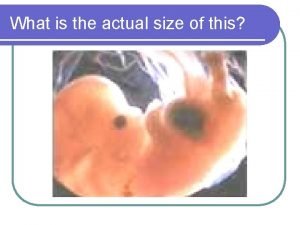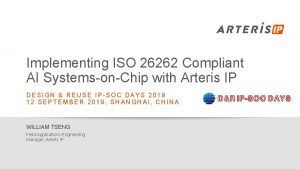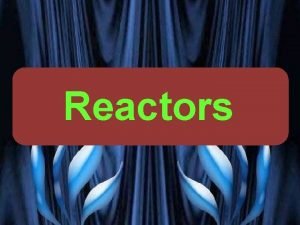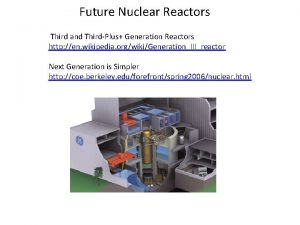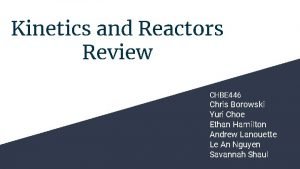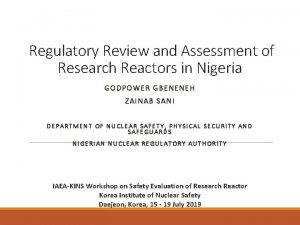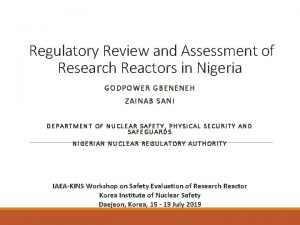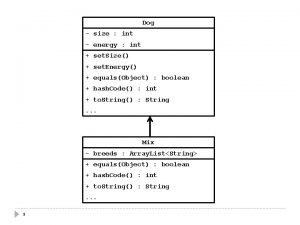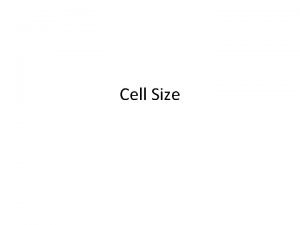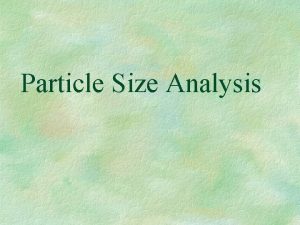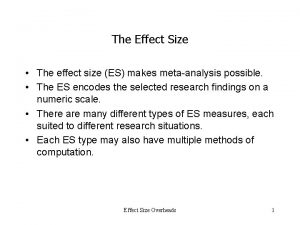L 2 1 Review What size reactors to




















- Slides: 20

L 2 -1 Review: What size reactor(s) to use? Answers to this questions are based on the desired conversion, selectivity and kinetics Reactor type & size Kinetics Material & energy balances Conversion & selectivity Slides courtesy of Prof M L Kraft, Chemical & Biomolecular Engr Dept, University of Illinois at Urbana-Champaign.

L 2 -2 Review: Rate Law for rj • r. A: the rate of formation of species A per unit volume [e. g. , mol/m 3 • s] • -r. A: the rate of a consumption of species A per unit volume 1 st order in A, 1 st order in B, 2 nd order overall nth order in A Michaelis-Menton: common in enzymatic reactions rj depends on concentration and temperature: Slides courtesy of Prof M L Kraft, Chemical & Biomolecular Engr Dept, University of Illinois at Urbana-Champaign.

L 2 -3 Review: Basic Molar Balance (BMB) Fj 0 Gj Fj System volume Rate of Rate of flow of j - flow of j out + generation of j - decomposition = accumulation into system of system by chemical rxn of j If the system is uniform throughout its entire volume, then: Moles j Moles generated per = per unit time and unit time (mol/s) volume (mol/s • m 3) Volume (m 3) Slides courtesy of Prof M L Kraft, Chemical & Biomolecular Engr Dept, University of Illinois at Urbana-Champaign.

L 2 -4 Review: BMB Equations Fj 0 Gj Fj System volume In - Out + Generation = Accumulation Next: Apply BME to ideal batch, CSTR, & PFR reactors Slides courtesy of Prof M L Kraft, Chemical & Biomolecular Engr Dept, University of Illinois at Urbana-Champaign.

L 2: Reactor Molar Balances & Considerations Fj 0 Gj L 2 -5 Fj reactor Today we will use BMB to derive reactor design equations. Your goal is to learn this process, not to memorize the equations! Slides courtesy of Prof M L Kraft, Chemical & Biomolecular Engr Dept, University of Illinois at Urbana-Champaign.

L 2 -6 Batch Reactors Properties • Reactants are placed in the reactor, and the reaction is allowed to proceed for some amount of time • Closed system- no addition of reactants or removal of products during the reaction • Unsteady-state conditions- the composition changes with time • Ideal batch reactor- vessel is perfectly mixed • Concentration and temperature are spatially constant, but NOT constant in TIME Slides courtesy of Prof M L Kraft, Chemical & Biomolecular Engr Dept, University of Illinois at Urbana-Champaign.

L 2 -7 Examples of Batch Reactor Lab-Scale Batch Reactor Typical Commercial Batch Reactor Motor for agitation Slides courtesy of Prof M L Kraft, Chemical & Biomolecular Engr Dept, University of Illinois at Urbana-Champaign.

L 2 -8 Basic Mole Balance for Batch Reactor No flow in or out! Fj 0 F In - Out + Generation = Accumulation X X j 0 0 Batch Reactor Design Equation If the reactor is perfectly mixed, the temperature, concentration, & therefore the reaction rate are spatially constant: Ideal Batch Reactor Design Equation Slides courtesy of Prof M L Kraft, Chemical & Biomolecular Engr Dept, University of Illinois at Urbana-Champaign.

Continuous Stirred Tank Reactor (CSTR) Properties L 2 -9 • Continuously add reactants and remove products (open system) • Inlet stream instantaneously mixes with bulk of reactor volume • Ideal batch reactor- assume perfect mixing occurs in vessel • Temperature and concentration are uniform throughout space • Composition of the exit stream is the same as that inside reactor (CA, outlet = CA, tank) • Steady-state conditions- the reaction rate is the same at every point and does not change with time Slides courtesy of Prof M L Kraft, Chemical & Biomolecular Engr Dept, University of Illinois at Urbana-Champaign.

L 2 -10 Examples of CSTRs Laboratory-Scale Bioreactor Pfaudler Inc. Slides courtesy of Prof M L Kraft, Chemical & Biomolecular Engr Dept, University of Illinois at Urbana-Champaign.

L 2 -11 Basic Mole Balance for CSTR In - Out + Generation = Accumulation CSTR is at steady state (SS), so no change in moles j with time! 0 Fj Steady State CSTR Design Equation A perfectly mixed CSTR has no spatial variations in reaction rate Rearrange to put in terms of V rj is measured at the outlet because Cj, exit = Cj, tank Ideal Steady State CSTR Design Equation Slides courtesy of Prof M L Kraft, Chemical & Biomolecular Engr Dept, University of Illinois at Urbana-Champaign.

L 2 -12 Ideal SS CSTR Design Equation Reactor volume required to reduce the entering flow rate of species j from Fj 0 to Fj at the outlet (and in the tank) How do we determine the molar flow rate, Fj (units = mol/time)? Cj: concentration of j : volumetric flow rate Ideal SS CSTR design equation in terms of concentration: Slides courtesy of Prof M L Kraft, Chemical & Biomolecular Engr Dept, University of Illinois at Urbana-Champaign.

Plugged Flow Reactor (PFR) Properties L 2 -13 • Also called a tubular reactor • Cylindrical pipe with openings at both ends • Steady movement of material down length of reactor • Reactants are consumed as they flow down the length of the reactor • Operated at steady state: • No radial variation in temperature, concentration, or reaction rate • All fluid/gas elements have the same residence time Slides courtesy of Prof M L Kraft, Chemical & Biomolecular Engr Dept, University of Illinois at Urbana-Champaign.

L 2 -14 Industrial PFRs Polyethylene reactor: • 16 inch inner diameter • Operates at 35, 000 psi & 600 °F • Has a vertical orientation when in use Courtesy of Autoclave Engineers of Snap-tite, Inc. Slides courtesy of Prof M L Kraft, Chemical & Biomolecular Engr Dept, University of Illinois at Urbana-Champaign.

L 2 -15 Mole Balance – PFR In a plug flow reactor the composition of the fluid varies from point to point along a flow path. Consequently, the material balance for a reaction component must be made for a differential element of volume ΔV ΔV FA 0 FA Fj 0 - Fj + = Divide by DV 0 lim DV→ 0 If we assume the PFR is ideal, the degree of completion is not affected by PFR shape, only by PFR volume Ideal SS PFR Design Eq. Slides courtesy of Prof M L Kraft, Chemical & Biomolecular Engr Dept, University of Illinois at Urbana-Champaign.

L 2 -16 Packed Bed Reactors (PBR) • Cylindrical shell, vertically oriented • Often gravity-driven flow • Heterogeneous reaction: fixed bed of catalyst inside • Reactants enter top and flow through the packed bed of catalyst • Concentration gradient of reactant and product down the length of the reactor • Reaction occurs on the surface of the catalyst pellets • Reaction rate is based on the mass of the solid catalyst, W, not reactor volume V Slides courtesy of Prof M L Kraft, Chemical & Biomolecular Engr Dept, University of Illinois at Urbana-Champaign.

Mole Balance- Packed Bed Reactor (PBR) L 2 -17 Similar to PFR, but we want to express it in terms of catalyst weight instead of reactor volume Units for the rate of a homogeneous rxn (rj) : Units for the rate of a catalytic rxn (rj’) : So rewriting the PFR design equation in terms of catalyst weight instead of reactor volume: Slides courtesy of Prof M L Kraft, Chemical & Biomolecular Engr Dept, University of Illinois at Urbana-Champaign.

L 2 -18 Mole Balances on Common Reactors Slides courtesy of Prof M L Kraft, Chemical & Biomolecular Engr Dept, University of Illinois at Urbana-Champaign.

L 2 -19 Selection of Reactors Batch • • small scale production of expensive products (e. g. pharmacy) high labor costs per batch difficult for large-scale production CSTR: most homogeneous liquid-phase flow reactors • when intense agitation is required • relatively easy to maintain good temperature control • the conversion of reactant per volume of reactor is the smallest of the flow reactors - very large reactors are necessary to obtain high conversions PFR: most homogeneous gas-phase flow reactors • relatively easy to maintain • usually produces the highest conversion per reactor volume (weight of catalyst if it is a packed-bed catalyze gas reaction) of any of the flow reactors • difficult to control temperature within the reactor • hot spots can occur Slides courtesy of Prof M L Kraft, Chemical & Biomolecular Engr Dept, University of Illinois at Urbana-Champaign.

L 2 -20 Uses for Various Reactors • Noncatalytic homogeneous gas reactor • Homogeneous liquid reactor • Liquid-liquid reactor • Gas-liquid reactor • Non-catalytic gas-solid reactor – Fixed bed – Fluidized bed • Fixed bed catalytic reactor • Fluid bed catalytic reactor • Gas-liquid-solid reactor • Ethylene polymerization (high pressure) • Mass polymerization of styrene • Saponification of fats • Nitric acid production • Iron production • Chlorination of metals • Ammonia synthesis • Catalytic cracking (petroleum) • Hydrodesulphurization of oils Slides courtesy of Prof M L Kraft, Chemical & Biomolecular Engr Dept, University of Illinois at Urbana-Champaign.
 Low voltage three phase choke coil filter reactor in pfc
Low voltage three phase choke coil filter reactor in pfc Define the term size separation
Define the term size separation Const char * vs char * const
Const char * vs char * const Nader amin-salehi
Nader amin-salehi Search strategy example
Search strategy example Chapter review motion part a vocabulary review answer key
Chapter review motion part a vocabulary review answer key Narrative review vs systematic review
Narrative review vs systematic review Writ of certiorari ap gov example
Writ of certiorari ap gov example Geology grain size card
Geology grain size card Nums24
Nums24 Lymphocyte size
Lymphocyte size Réduction de dimension
Réduction de dimension Factors affecting sample size
Factors affecting sample size Which size
Which size Paediatric et tube size formula
Paediatric et tube size formula Initial sample size
Initial sample size Work out the size of angle x
Work out the size of angle x Opinion size age colour material
Opinion size age colour material The actual size of a paramecium is about
The actual size of a paramecium is about Tori npu ai size
Tori npu ai size Size 0 models
Size 0 models
